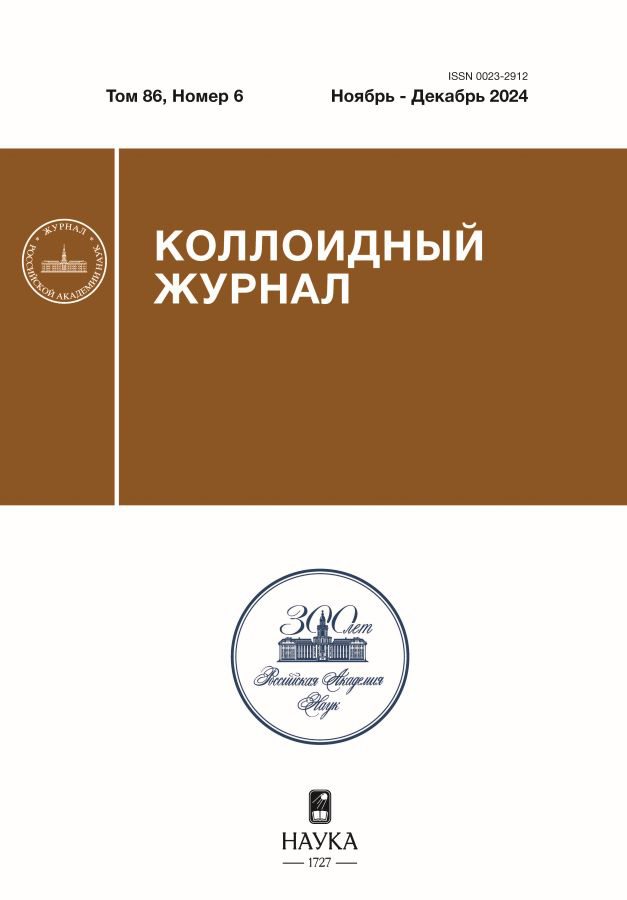Tween 80 aqueous micellar solutions as wetting agents and permeability enhancers of potato leaves
- Authors: Zadymova N.M.1, Skvortsova Z.N.1,2, Aleksandrov Y.D.1,2, Ilina I.Y.2
-
Affiliations:
- Московский государственный университет имени М.В. Ломоносова
- Институт биоорганической химии им. академиков М.М. Шемякина и Ю.А. Овчинникова РАН
- Issue: Vol 86, No 6 (2024)
- Pages: 720-726
- Section: Articles
- Submitted: 29.05.2025
- Published: 15.12.2024
- URL: https://ter-arkhiv.ru/0023-2912/article/view/681009
- DOI: https://doi.org/10.31857/S0023291224060056
- EDN: https://elibrary.ru/VLMPKX
- ID: 681009
Cite item
Abstract
In order to develop innovative methods of plant protection, the key properties of Tween 80 aqueous micellar solutions as means of delivery of biologically active substances inhibiting the reproduction of various pathogens have been studied. The absence of negative effects of these solutions upon contact with potato leaves has been shown. The wetting isotherms for Tween 80 aqueous solutions confirmed the hydrophilization of the potato leaf and the hydrophobic polymer film modeling its surface. By combining the methods of tensiometry and wetting, the maximum adsorption of Tween 80 on the surface of the polymer was determined, which made it possible to predict the structure of the adsorption layer of this surfactant on the surface of the potato leaf. For micellar solutions of Tween 80, characterized by maximum wetting ability, a significant increase in the rate of penetration into the leaf was recorded.
Full Text
About the authors
N. M. Zadymova
Московский государственный университет имени М.В. Ломоносова
Author for correspondence.
Email: nzadymova@gmail.com
Химический факультет
Russian Federation, Москва, 119991Z. N. Skvortsova
Московский государственный университет имени М.В. Ломоносова; Институт биоорганической химии им. академиков М.М. Шемякина и Ю.А. Овчинникова РАН
Email: nzadymova@gmail.com
Химический факультет Московского государственного университета имени М.В. Ломоносова
Russian Federation, Москва, 119991; Москва, 117997Yu. D. Aleksandrov
Московский государственный университет имени М.В. Ломоносова; Институт биоорганической химии им. академиков М.М. Шемякина и Ю.А. Овчинникова РАН
Email: nzadymova@gmail.com
Химический факультет Московского государственного университета имени М.В. Ломоносова
Russian Federation, Москва, 119991; Москва, 117997I. Yu. Ilina
Институт биоорганической химии им. академиков М.М. Шемякина и Ю.А. Овчинникова РАН
Email: nzadymova@gmail.com
Russian Federation, Москва, 117997
References
- Морозов С.Ю., Соловьев А.Г., Калинина Н.О., Тальянский М.Э. Двуспиральные РНК как средство защиты растений от патогенных организмов и вирусов культивируемых растений // Acta Nat. (русскоязычная версия). 2019. Т. 11. № 4. С. 13–21. 10.32607/20758251-2019-11-4-13-21' target='_blank'>https://doi: 10.32607/20758251-2019-11-4-13-21
- Соколов М.С., Санин С.С., Долженко В.И., и др. Концепция фундаментально-прикладных исследований защиты растений и урожая // Агрохимия. 2017. № 4. С. 3–9.
- Holloway P.J. Surface factors affecting the wetting of leaves // Pestic. Sci. 1970. V. 1. № 4. P. 156–163.https://doi.org/10.1002/ps.2780010411
- Taylor P. The wetting of leaf surfaces // Curr. Opin. Colloid Interface Sci. 2011. V. 16. P. 326–334. https://doi.org/10.1016/j.cocis.2010.12.003
- Massinon M., Lebeau F. Review of physicochemical processes involved in agrochemical spray retention // Biotechnol. Agron. Soc. Environ. 2013. V. 17. № 3. P. 494–504.
- Puente D.W., Baur P. Wettability of soybean (Glycine max L.) leaves by foliar sprays with respect to developmental changes // Pest Manag. Sci. 2011. V. 67. № 7. P. 798–806. https://doi.org/10.1002/ps.2116
- Forster W.A., Zabkiewicz J.A. Improved method for leaf surface roughness characterization // Proceedings of the 6th International Symposium on Adjuvants for Agrochemicals. ISAA. Amsterdam, Netherlands. 2001. P. 113–118. https://doi.org/10.1515/ci.2001.23.1.27a
- Gaskin R.E., Steele K.D., Forster W.A. Characterising plant surfaces for spray adhesion and retention // N. Z. Plant Prot. 2005. V. 58. P. 179–183. https://doi.org/10.30843/nzpp.2005.58.4244
- van Overbeek J. Absorption and translocation of plant regulators // Annu. Rev. Plant. Physiol. 1956. V. 7. P. 355–372. https://doi.org/10.1146/annurev.pp.07.060156.002035
- Zhu F., Cao C., Lidong Cao L. et al. Wetting behavior and maximum retention of aqueous surfactant solutions on tea leaves // Molecules. 2019. V. 24. P. 2094–3010. https://doi.org/10.3390/molecules24112094
- L-77 Silicone Surfactant/Technical Data Sheet. Производитель Momentive. https://www.momentive.com/docs/default-source/tds/silwet/silwet-l-77-tds.pdf
- Задымова Н.М., Александров Ю.Д., Калинина Н.О., Тальянский М.Э., Скворцова З.Н. Водные субмикронные дисперсии поверхностно-активных веществ как смачиватели и усилители проницаемости листьев картофеля // Журн. Общ. Хим. 2023. Т. 93. № 11. C. 1785–1795. https://doi.org/10.31857/S0044460X2311015X
- Sankaran A., Karakashev S.I., Sett S. et al. On the nature of the superspreaders // Adv. Colloid Interface Sci. 2019. V. 263. P. 1–18. https://doi.org/10.1016/j.cis.2018.10.006
- Критическая концентрация мицеллообразования Tween 80. https://www.sigmaaldrich.com/RU/en/product/sial/p1754?icid=sharepdp-clipboard-copy-productdetailpage
- Критическая концентрация мицеллообразования додецилтриметил аммоний хлорида. https://www.muctr.ru/upload/iblock/46f/46fc7278c7280f6d0778207dc9a1213f.pdf
- Zadymova N.M., Poteshnova M.V. Microemulsions and microheterogeneous microemulsion-based polymeric matrices for transdermal delivery of lipophilic drug (Felodipine) // Colloid Polym. Sci. 2019. V. 297. P. 453–468. https://doi.org/10.1007/s00396-018-4447-z
- Холмберг К., Йёнссон Б., Кронберг Б., Линдман Б. Поверхностно-активные вещества и полимеры в водных растворах. М.: БИНОМ. Лаборатория знаний. 2007.
- Задымова Н.М., Иванова Н.И. Смешанные мицеллы на основе Твин 80 как носители фелодипина в водной среде // Коллоид. журн. 2013. Т. 75. № 2. С. 179–190. https://doi.org/10.7868/s0023291213020201
- Потешнова М.В., Задымова Н.М. Водные растворы гидроксипропилцеллюлозы, Твин 80 и их бинарных смесей: коллоидно-химические аспекты // Коллоидн. журн. 2017. Т. 79. № 6. С. 766–777. https://doi.org/10.7868/S002329121706009X
- Dybing C. D., Currier H. B. Foliar penetration by chemicals // Plant Physiology. 1961. V. 36. № 2. P. 169–174. https://www.jstor.org/stable/4259738
Supplementary files















